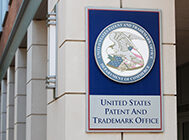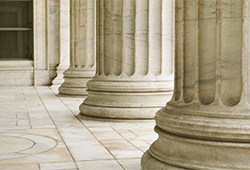Federal Circuit Remands to USPTO to Clarify Analysis of Jepson-Format and Means-Plus-Function Claims in the Field of Biotechnology
 On January 23, 2024, the U.S. Court of Appeals for the Federal Circuit (“Federal Circuit”) issued its decision granting the USPTO’s request to remand Xencor’s appeal of the rejection of U.S. Patent App. No 16/803,690 (“’690 patent application”) back to the USPTO. The USPTO requested remand so that the USPTO’s Appeals Review Panel can “clarify the USPTO’s position on the proper analysis of Jepson-format and means-plus function claims in the field of biotechnology, and particularly in the antibody art,” and issue “a revised decision.”
On January 23, 2024, the U.S. Court of Appeals for the Federal Circuit (“Federal Circuit”) issued its decision granting the USPTO’s request to remand Xencor’s appeal of the rejection of U.S. Patent App. No 16/803,690 (“’690 patent application”) back to the USPTO. The USPTO requested remand so that the USPTO’s Appeals Review Panel can “clarify the USPTO’s position on the proper analysis of Jepson-format and means-plus function claims in the field of biotechnology, and particularly in the antibody art,” and issue “a revised decision.”
The claims at issue in the ’690 patent application cover use of anti-C5 antibodies with an Fc domain. The claims were drafted in both the “Jepson” and means-plus-function format (claims 8 and 9, respectively):
- In a method of treating a patient by administering an anti-C5 antibody with an Fc domain, the improvement comprising said Fc domain comprising amino acid substitution M428L/N434S as compared to a human Fc polypeptide, wherein numbering is according to the EU index of Kabat, wherein said anti-C5 antibody with said amino acid substitution has increased in vivo half-life as compared to said antibody without said substitutions.
- A method of treating a patient by administering an anti-C5 antibody comprising: a) means for binding human C5 protein; and b) an Fc domain comprising amino acid substitution M428L/N434S as compared to a human Fc polypeptide, wherein numbering is according to the EU index of Kabat, wherein said anti-C5 antibody with said amino acid substitution has increased in vivo half-life as compared to said antibody without said substitutions.
The examiner had rejected the claims as unpatentable (a) for failing to comply with the written description requirement, and (b) under the obviousness-type double patenting doctrine. Xencor appealed the rejection to the Patent Trial and Appeal Board (“PTAB”), after which the examiner withdrew the written description rejection.
In its decision, the PTAB reinstated the written description rejection. Xencor appealed to the Federal Circuit. Following the filing of Xencor’s appeal brief, the Director of the USPTO filed a motion for remand back to the USPTO “to permit further consideration and issuance of a revised decision by the Appeals Review Panel.” The Director’s motion for remand stated that:
Xencor’s pending claims present novel questions involving the application of the Supreme Court’s and this Court’s precedent for both Jepson-format and means-plus-function claims in the field of biotechnology, and in particular the antibody art. The use of Jepson format and means-plus-function claims in the life sciences is exceedingly rare. Therefore, the USPTO seeks remand in order to issue a revised decision that clearly and thoroughly expresses the Agency’s view on application of the case law to this important area of technology.
While Xencor opposed the USPTO’s request as arising too late, the Federal Circuit ultimately sided with the USPTO. In its decision, the Federal Circuit wrote that the Director raised legitimate concerns and that it was “confident that proceedings will be conducted expeditiously.”
 On December 26, 2023, the United States Court of Appeals for the Federal Circuit issued its
On December 26, 2023, the United States Court of Appeals for the Federal Circuit issued its  On January 16, 2024, the Patent Trial and Appeal Board (PTAB) of the United States Patent and Trademark Office issued a
On January 16, 2024, the Patent Trial and Appeal Board (PTAB) of the United States Patent and Trademark Office issued a  On October 10, 2023, the Enlarged Board of Appeal of the European Patent Office (EPO) issued a
On October 10, 2023, the Enlarged Board of Appeal of the European Patent Office (EPO) issued a  Last week,
Last week,  The U.S. Supreme Court has decided a closely watched case regarding patent law’s enablement requirement, Amgen Inc. v. Sanofi. The Supreme Court affirmed the Federal Circuit’s decision that Amgen’s patent claims were invalid, holding that the patents’ disclosures “offer[ed] persons skilled in the art little more than advice to engage in ‘trial and error.’”
The U.S. Supreme Court has decided a closely watched case regarding patent law’s enablement requirement, Amgen Inc. v. Sanofi. The Supreme Court affirmed the Federal Circuit’s decision that Amgen’s patent claims were invalid, holding that the patents’ disclosures “offer[ed] persons skilled in the art little more than advice to engage in ‘trial and error.’” The United States Patent & Trademark Office (USPTO or PTO) recently announced
The United States Patent & Trademark Office (USPTO or PTO) recently announced  In a letter dated March 21, 2023, the National Institutes of Health (“NIH”) again refused the request of petitioners to exercise march-in rights under the Bayh-Dole Act to control the price of a drug. Here, as before, the NIH found that the statutory criteria for the use of march-in rights were not satisfied by the petitioners.
In a letter dated March 21, 2023, the National Institutes of Health (“NIH”) again refused the request of petitioners to exercise march-in rights under the Bayh-Dole Act to control the price of a drug. Here, as before, the NIH found that the statutory criteria for the use of march-in rights were not satisfied by the petitioners. Director Katherine Vidal of the U.S. Patent and Trademark Office (“USPTO”) issued a precedential review decision with respect to the interpretation of multiple dependent claims, in a case of first impression before the Patent and Trial Appeal Board (“PTAB”). In the review of the PTAB’s final written Decision and Order, the Director modified it consistent with her determination of the treatment of multiple dependent claims, which are claims that refer to and incorporate by reference more than one other claim.
Director Katherine Vidal of the U.S. Patent and Trademark Office (“USPTO”) issued a precedential review decision with respect to the interpretation of multiple dependent claims, in a case of first impression before the Patent and Trial Appeal Board (“PTAB”). In the review of the PTAB’s final written Decision and Order, the Director modified it consistent with her determination of the treatment of multiple dependent claims, which are claims that refer to and incorporate by reference more than one other claim. The Unified Patent Court (“UPC”) is set to begin on June 1, 2023. Under the UPC framework, a single court proceeding could result in simultaneous revocation of European Patents across multiple European Union (“EU”) countries, including France and Germany.
The Unified Patent Court (“UPC”) is set to begin on June 1, 2023. Under the UPC framework, a single court proceeding could result in simultaneous revocation of European Patents across multiple European Union (“EU”) countries, including France and Germany.